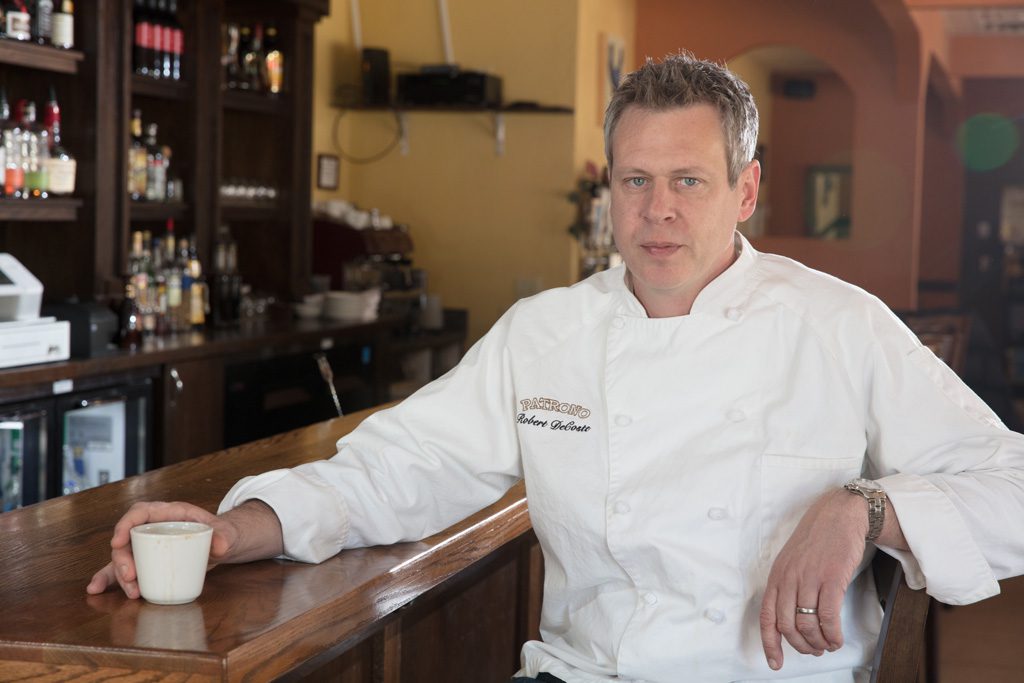
[dropcap]Robert[/dropcap] DeCoste has worked in restaurants since he was 14, but it wasn’t until he was on his honeymoon that the owner and chef of Patrono in Oklahoma City found what he truly wanted to cook.
“I’d worked in a few Italian restaurants, and they weren’t doing traditional Italian food,” he said. “They were trying to do modern Italian. When my wife and I got married, we went to Italy for our honeymoon. I had the actual dishes in Italy the way they were meant to be made, and I just thought it was so much better.
“I don’t try to reinvent classic dishes. I try to prepare food the way it has been done ever since the recipe was first created.”
That’s why his menu has linguine vongole (clams with garlic and peppers), orecchiette calabrese (chicken thighs with bread crumbs and parmigiano reggiano) and chicken al mattone (a 10-ounce breast grilled “with a brick”).
DeCoste started as a dishwasher as a summer job in his home state of Massachusetts and says he was amazed about how much happened in the kitchen and what it took to make a restaurant work. That energy drew him to the business and has kept him in it since.
He worked there for seven years before deciding to make the move into fine dining. He left Massachusetts for New Orleans and worked with Paul Prudhomme. After that, he moved back to Massachusetts and worked for Todd English at Olives, eventually serving as executive chef there and at Notti Bianche in Washington.
“That’s when Todd English just made it big,” he says. “He had just put out his cookbook and opened his second restaurant. That’s probably where I learned the most, at Olives.”
When DeCoste’s wife, Amanda Yaun, a neurological surgeon, was recruited by OU Medical Center, the two decided to make the move for multiple reasons, including the high cost of starting a restaurant in the Boston or Washington. In Oklahoma City, DeCoste began his restaurant in the growing Avana Arts District, across the street from the Oklahoma City Museum of Art.
“That was part of the reason we thought this was a good move, not just for her but also for me, because we could open a restaurant and get in just as stuff was getting off the ground – before real estate prices get too high,” he says. “It’s a good idea to get in now and build a name before it gets too big.”
No matter how good DeCoste’s timing was, Patrono’s relies on its food and DeCoste’s classic approach to dishes for its success. While many restaurants may keep trying new approaches in order to make their entrees different, DeCoste knows adding new flavors just for the sake of it is rarely the best approach.
“That’s what I try to avoid,” he says. “You have to know when to stop, when to say, ‘OK, this dish is perfect.’ It doesn’t need that one extra thing that’s going to throw people off.”
Winter Spiced Bolognese Serves 6 to 8
- 3 tbsp. olive oil
- 12 ounces ground pork or veal
- 12 ounces ground beef
- 1 celery stalk, diced
- 1 carrot, diced
- 1 onion, diced
- 4 cloves garlic, minced
- 1/2 cup dry red wine
- 1 cup beef broth
- 1 16 ounce can of tomatoes, preferably San Marzano, pureed
- 3/4 tsp. cinnamon
- 1/2 tsp. nutmeg
- salt and pepper
- 1/4 cup heavy cream
- 1 pound your choice of pasta cooked (I suggest a wide flat noodle such as Pappardelle or Fettuccine)
- 1/2 cup fresh grated Parmigiano Reggiano
- or 1/2 cup ricotta cheese
Heat the olive oil in a deep saucepan. Add the ground veal/pork and beef and cook over high heat until browned and remove from the pot leaving just enough oil to cook the vegetables.
Reduce the heat to medium and add the celery, carrot, onion and garlic and cook until tender.
Return the meat to the pot and add the red wine and reduce by half. Add the beef stock, tomato, cinnamon and nutmeg and simmer over low heat covered for about 2 hours.
Add the cream just before serving, blend well, season with salt and pepper and toss with your choice of pasta and top with cheese.






















